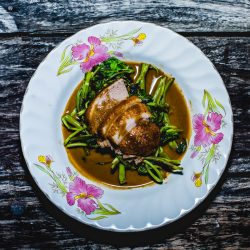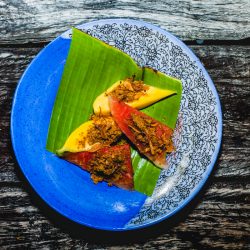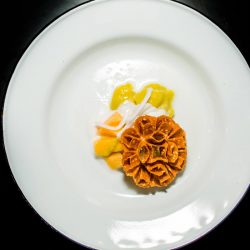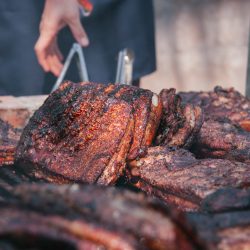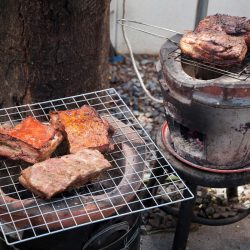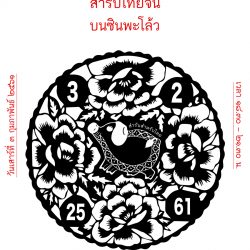MEET A GROUP OF CHEFS AND A DESIGNER WHO WANT TO CREATE A PLATFORM FOR CREATIVELY INTRODUCING THAI RECIPES TO A WIDER AUDIENCE
Samrub for Thai created its first ‘Samrub’ (a set of a variety of dishes) at Jack’s Bar in 2017 with the given name of ‘Samrub No. 1 : Thai meal meets Local waterfront lifestyle.’ Prin Polsuk, the head chef of nahm, along with Mint Jarukittikun and a number of staff borrowed the kitchen of Uncle Jack’s bar. They reorganized the restaurant’s cluster of separate tables into a long dining table to create a more intimate atmosphere and three canapés were served with the main course being a stir-fried dish, a salad, a curry and a dessert to close the meal.
The pop-up restaurant by Samrub for Thai was easily made with a theme and a venue that was followed by an online invitation that welcomed people to share the meal. Samrub for Thai was born from the meeting of minds between Mint Jarukittikun, a designer and food enthusiast who views the essence of dining out as an experience, not just a meal that keeps one’s stomach full, and Prin Polsuk, the head chef of the renowned nahm Bangkok who once oversaw the operation of nahm London and the team of chefs (also from nahm), namely Waraphan Chanthong, Aruss Lerlerstkul, Anon Pichayamongkol and Geravich Mesaengnilverakul. “My educational backgroundis in engineering but it wasn’t that much of a success. I’ve always liked to read. I read everything and fall for Rong Wonsawan’s works. I decided to pursue an interest in philosophy before I went on to take a Thai cooking class at the Oriental Hotel, Bangkok,” Polsuk told art4d sharing that one of the most important turning points of his life was when he received an offer to work with David Thompson at the Australian Embassy for two years and the opportunity to work at nahm restaurant in London, which served as a stepping stone to his position as the head chef at nahm Bangkok.
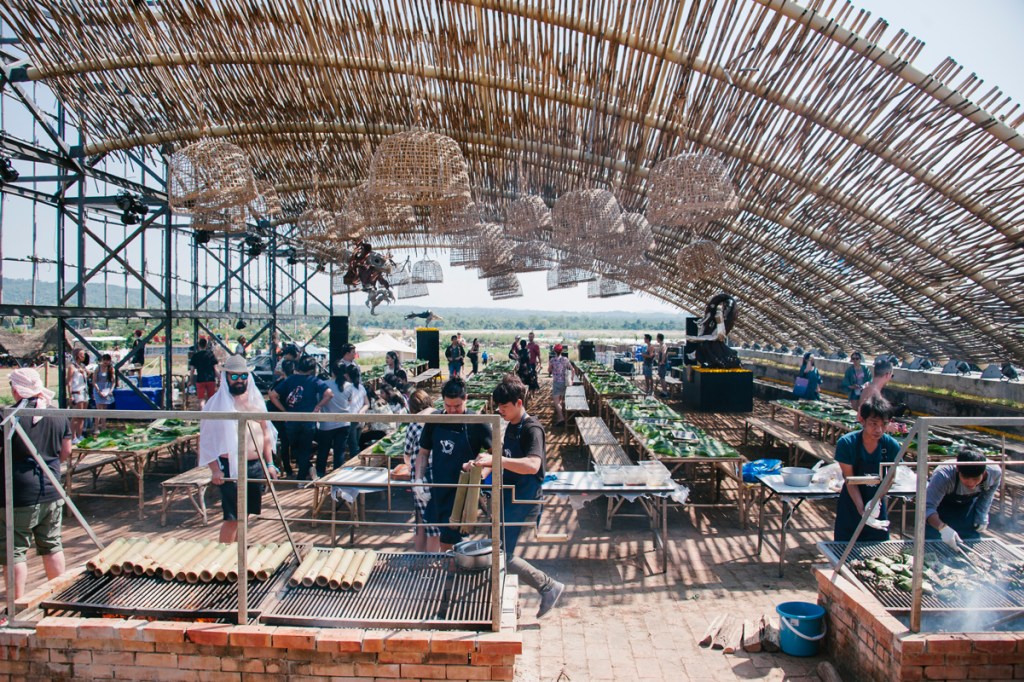
Working with David Thompson affected the way Samrub for Thai worked more than they would have expected, especially after the reading of over a thousand books from the Australian chef’s collection. “It all began with the funeral book of Thanpuying Plien Passakornwong. Everything started from there. It was as if my brain was dissected. I was introduced to ingredients I never knew existed like Pro Hom (Galangal), which required quite a lot of hard work to find but was well worth it because I wanted to make these dishes come to life. I started to question why these menus had disappeared and why people stopped making and eating them. These dishes were fading away from the knowledge and recognition of people.” One of the purposes of the previous pop-up restaurant or Samrub by Samrub for Thai in the past was derived from this reason, which is to promote and re-introduce a different facet of Thai food from the ingredients and thought processes to ultimately bringing the taste to the public. This also led to another interesting issue, which are the details regarding the way foods are made, which in Samrub for Thai’s case in particular, encompasses not only the use of hard-to-find ingredients and high-quality chili paste, but also the equally interesting formation of the menu.
“I feel like Thompson’s approach and methods are very authentic. It revolves around and explores the documented recipes in old cookbooks and reinterprets them. Such reinterpretation requires a great understanding of the historical context in which the food is conceived and perceived.” Samrub for Thai’s method is essentially the adaptation of ancient recipes found in old publications as well as funeral books with a mix of contemporary ingredients. For instance, the Pad Thai served at ‘Samrub No. 3: A Streetside Samrub by the Gallery’ was cooked with no tofu to be found but added were fermented bean, fish sauce, coconut sugar and mango, which is different from the Pad Thai we are all familiar with (those who got to eat it said that it tasted just as good). Inevitably people were particularly curious about having mango as one of the ingredients. “Everyone expected to see some tofu, which is what they would normally see with most Pad Thai that is being made out there, but we used fermented bean, fish sauce, and coconut sugar, which made us realize that there is so much more to this dish than people might think. We get used to what others have been creating for so long and that causes us to think that there is only one specific way to do it.” The dishes created by Samrub for Thai ask interesting questions such as why can’t Pad Thai have mango as an ingredient? Samrub for Thai is trying to question people’s perceptions towards a particular kind of food and ask them to rethink the tastes we define as good and delicious, considering that perhaps they were actually conceived differently and there is no reason for other possibilities to be regarded as false or unauthentic.

This very issue is the core concept of several other Samrubs that followed such as the POP-UP DINNER ‘CREATIVITY ONWARDS : Samrub Thansamai BY SAMRUB FOR THAI & THAAN’ held at 80/20 Restaurant, Charoenkrung 26, which is the presentation of modern Thai dishes that reinterpret popular ingredients and cooking methods in Thai cuisine. The experiment gives birth to an authentically Thai menu that comes in the rather western shape and form of blood sausage with Thanpuying Plien Passakornwong’s cookbook as its resource. They further experimented with the concept through the project, ‘The Funeral Book of Street Food,’ which participated in the BANGKOK ART BOOK FAIR 2017. The project returned to the root of Thai culinary culture while mocking the current situation at the time when the government vigorously attempted to organize and regulate Bangkok’s vibrant street food culture. It was the time when stories of street food vendors in Bangkok made headlines as the government made it their business to prevent street food from occupying the sidewalks of Bangkok. “Apart from the ancient books by Sor Phlainoi, Rong Wongsawan and the knowledge that I have developed over the years, Bank (Waraphan Chanthong) has been a great help with all the research, but there is still something missing so we haven’t really been able to connect all the dots.” Nonetheless, with the limited resources and information, the content in the book is divided into categories such as ‘Hawkers and Kiosks: Why Mae Kha?’ (which talks about the origin of the term mae-kha (a Thai word meaning a female vendor) or Curry Samrub (curry set) (the origin of curry and rice that dates back to the Ayutthaya era) and included are 15 recipes from the Thai street food repertoire.
“We don’t want to define what it (food) should be like. We just want to express what we believe through the food we create, the atmosphere and the conversations that take place over a meal,” Jarukittikun told art4d before adding that they don’t limit themselves to the role of one particular type of professional or practitioner doing just one particular thing. This is perhaps the reason behind the dilemma we (and quite a few people) are having at the moment, which is an attempt to define what Samrub for Thai actually is. It would be too narrow to define what they do by including them in the pop-up restaurant category and too commercial to call them a food stylist considering the fact that they are a group of professionally trained chefs who are working together on preserving these ancient recipes and keeping them from being kept in old cookbooks in somebody’s private collection. At the recently ended Bangkok Design Week 2018, Samrub for Thai joined the event with ‘Thai-Chinese meal on new road Charoenkrung’ at New Heng Ki restaurant, Charoenkrung road. Saran Yen Panya of 56th Studio and a number of designers collaborated on the project with their specially designed chairs acting as fun gimmicks for diners to enjoy the experience where the person who arrived first got to choose their chair first. As many of you may already know, all 40 seats were fully booked several days before the event.
สำรับสำหรับไทยเริ่มทำ ‘สำรับ’ ครั้งแรกที่ Jack Bar เมื่อปี 2017 ในชื่อ ‘สำรับที่ ๑ : สำรับไทย กับวิถีริมน้ำชาวกรุง’ ปริญญ์ ผลสุข หัวหน้าพ่อครัวจากร้านอาหาร nahm และธัญญพร จารุกิตติคุณ รวมถึงทีมงานอีกจำนวนหนึ่งได้ไปขอยืมครัวจากลุงแจ็ค (เจ้าของร้าน) จัดโต๊ะใหม่จากตั้งกระจายเป็นตัวๆ ให้เป็นโต๊ะยาวให้เกิดบรรยากาศใกล้ชิดเป็นกันเอง เสิร์ฟคานาเป้ 3 อย่าง เมนคอร์สเป็นอาหารจานผัด ยำ แกง และตบท้ายด้วยของหวานอีกหนึ่งจาน
ร้านอาหาร pop-up ของสำรับสำหรับไทยทำขึ้นง่ายๆ ด้วยการคิดธีมและหาสถานที่ ก่อนจะเชิญชวนคนเข้ามาร่วมโต๊ะอาหารกันผ่านทางโซเชียลมีเดีย สำรับสำหรับไทยเกิดจากการจับคู่กันของ ธัญญพร จารุกิตติคุณ ดีไซเนอร์ที่สนใจเรื่องอาหาร และมองว่าสาระสำคัญของการไปกินอาหารตามร้านไม่ได้อยู่ที่แค่การกินให้อิ่มแต่อยู่ที่ประสบการณ์ ตั้งแต่จองร้านและรอคิว “มันเหมือนกับการไปมิวเซียมที่แพงแต่เราก็อยากไปมากกว่า” กับ ปริญญ์ ผลสุข หัวหน้าเชฟจากร้านอาหาร nahm สาขากรุงเทพฯ ที่เคยไปประจำอยู่ที่ nahm สาขาลอนดอนมาระยะหนึ่ง และทีมเชฟจากร้าน nahm อย่าง วราพันธ์ จันทร์ธง อรุษ เลอเลิศกุล อานนท์ พิชยมงคล และจีราวิชช์ มีแสงนิลวีรกุล “ผมเคยเรียนวิศวะแต่ไม่ประสบความสำเร็จเท่าไหร่ พอดีเป็นคนชอบอ่านหนังสือ อ่านทุกอย่างจนมาจบที่ ’รงค์ วงษ์สวรรค์ ก็เลยหันไปเรียนด้านปรัชญา ต่อมาก็ไปลงเรียนคอร์สสอนอาหารไทยสั้นๆ ที่โรงแรมโอเรียนเต็ล” ปริญญ์บอกกับ art4d ว่าอีกจุดเปลี่ยนสำคัญคือ เมื่อได้ร่วมงานกับเชฟเดวิด (David Thompson) ที่สถานทูตออสเตรเลียเป็นเวลา 2 ปี และการได้รับโอกาสไปทำงานที่ร้านอาหาร nahm ที่ลอนดอน เพื่อที่จะกลับมาเป็น head chef ที่ nahm สาขากรุงเทพฯ
การร่วมงานกับเชฟเดวิดส่งผลต่อวิธีทำงานของสำรับสำหรับไทยมากกว่านั้น โดยเฉพาะการได้อ่านหนังสือที่เชฟเดวิดสะสมไว้กว่าพันเล่ม “ทุกอย่างมันเกิดจากหนังสืองานศพของท่านผู้หญิงเปลี่ยน ภาสกรวงศ์ ทุกอย่างเลย ทำให้สมองมันกระจาย อย่างวัตถุดิบที่ไม่เคยเห็นมาก่อน เปราะหอม ก็ไปดั้นด้นหามา อยากทำให้มันเกิดขึ้น ตั้งข้อสงสัยว่าทำไมมันหายไป ทำไมคนถึงไม่กินกัน ทุกวันนี้มันกลายเป็นว่าสิ่งเหล่านี้กำลังจะหายไป” จุดประสงค์หนึ่งของการจัดร้านอาหาร pop-up หรือ ‘สำรับ’ ครั้งที่ผ่านๆ มาของสำรับสำหรับไทยเกิดขึ้นจากเหตุผลนี้ คือการเผยแพร่อาหารไทยในแบบอื่น ทำจากวัตถุดิบและวิธีคิดอื่นๆ ให้กับสาธารณชนได้กิน ซึ่งนำไปสู่อีกประเด็นหนึ่งที่น่าสนใจคือ รายละเอียดของกระบวนการทำอาหารของสำรับสำหรับไทย ที่นอกจากจะให้ความสำคัญกับการเลือกใช้วัตถุดิบหายากคุณภาพของเครื่องปรุงเครื่องแกงแล้ว ขั้นตอนการคิดเมนูก็เป็นอีกเรื่องที่น่าสนใจทีเดียว
“เรารู้สึกว่าวิถีของเชฟเดวิดมันจริงแท้ มันคือการเอาตำราเก่ามาอ่าน มาตีความใหม่ ซึ่งการตีความนี้มันต้องอาศัยความเข้าใจบริบททางประวัติศาสตร์ บริบทของการทำในสมัยนั้น” วิถีการทำอาหารของสำรับสำหรับไทยคือการนำสูตรอาหารตามหนังสือโบราณ หนังสืองานศพ มาปรับเปลี่ยนส่วนผสมบางอย่างให้ร่วมสมัยขึ้น ยกตัวอย่างเช่น ผัดไทยในงาน ‘สำรับที่ ๓ : สำรับริมทางข้างๆ แกลเลอรี’ ที่เป็นผัดไทยแบบที่ไม่มีเต้าหู้แต่ใส่เต้าเจี้ยว น้ำปลา น้ำตาลปี๊บ และมะม่วง ไม่เหมือนกับผัดไทยแบบมาตรฐานที่เราเคยกิน (แต่คนที่ได้กินวันนั้นบอกว่าอร่อยไม่แพ้กัน) จนหลายๆ คนสงสัยกันว่าทำไมผัดไทยจานนี้ถึงใส่มะม่วง? “ทุกคนคิดว่าผัดไทยจะมีเต้าหู้เหมือนที่ขายๆ กัน แต่เราใส่เต้าเจี้ยว ใส่น้ำปลา น้ำตาลปี๊ป ผัดไทยจานนี้ทำให้เรารู้สึกว่า มันมีอะไรมากกว่าที่เราคิดว่ามันใช่ เพราะเราถูกสร้างโดยคนอื่นให้เราคิดว่ามัน (อาหาร) ต้องเป็นแบบใดแบบหนึ่งเท่านั้น” พร้อมกันนั้นเอง ในจานอาหารที่สำรับสำหรับไทยทำออกมาจึงเป็นการตั้งคำถามที่น่าสนใจกว่าย้อนกลับไปยังฝั่งคนกินว่า แล้วทำไมผัดไทยต้องไม่ใส่มะม่วง? สำรับสำหรับไทยกำลังพยามยามตั้งคำถามต่อ ‘การรับรู้’ ของคนในปัจจุบันที่มีต่ออาหารชนิดหนึ่งว่าสิ่งที่เรากินกันจนชินอยู่ทุกวันนี้ จริงๆ แล้วในตอนที่มันเกิดขึ้นมาเป็นแบบนี้หรือไม่? และทำไมมันจะเป็นอย่างอื่นไม่ได้?
ประเด็นคำถามเดียวกันนี้เป็นแนวคิดที่อยู่ในการทำสำรับหลายๆ ครั้งที่ผ่านมา อย่างที่เห็นได้ใน ‘สำรับที่ ๒ : สำรับทานสมัย’ จัดขึ้นที่ร้านอาหาร 80/20 เจริญกรุง เป็นการนำเสนอมุมมองของอาหารไทยในสมัยนี้ โดยนำวัตถุดิบที่เราคุ้นเคยกันในปัจจุบันมาตีความและปรุงในวิธีใหม่ จนกลายมาเป็นเมนูไทยแท้แต่หน้าตาฝรั่งอย่างไส้กรอกเลือดที่ต้นทางมาจากหนังสือแม่ครัวหัวป่าก์ของคุณหญิงเปลี่ยน ภาสกรวงศ์นอกจากนี้พวกเขายังต่อยอดประเด็นนี้ในโปรเจ็คต์ ‘หนังสืองานศพอาหารริมทาง’ ในงาน BANGKOK ART BOOK FAIR 2017 ด้วยการย้อนกลับไปหารากเหง้าของวัฒนธรรมการกินของคนไทยในอดีต ล้อรับไปกับสถานการณ์ ณ ช่วงเวลานั้นที่มีข่าวว่าภาครัฐจะจัดระเบียบทางเท้าในกรุงเทพฯ และจะไม่อนุญาตให้ร้านอาหารริมทางตั้งร้านริมถนนอีกต่อไป “นอกจากหาอ่านจากหนังสือโบราณต่างๆ อย่างเช่น ส.พลายน้อย ’รงค์ วงษ์สวรรค์ มาปะติดปะต่อกับความรู้ที่เรามีอยู่แล้วบ้าง ก็มี แบงค์ (วราพันธ์ จันทร์ธง) ช่วยเราค้นข้อมูล แต่มันมีหลายเรื่องที่เราไม่สามารถเอามาเชื่อมกันได้” อย่างไรก็ตาม ด้วยข้อจำกัดของข้อมูล เนื้อหาในเล่มจึงถูกแยกออกเป็นหัวข้อๆ เช่น ‘วิถีหาบเร่-แผงลอย’ ‘ทำไมต้องแม่ค้า?’ (พูดถึงที่มาของคำเรียก ‘แม่ค้า’) หรือ ‘สำรับข้าวแกง’ (ที่มาของข้าวแกงที่ย้อนไปถึงสมัยอยุธยา) แนบท้ายด้วยตำรับอาหารริมทาง 15 ตำรับ
“เราไม่ได้ต้องการบอกว่า จริงๆ แล้วมัน (อาหาร) ต้องเป็นยังไง เราแค่แสดงสิ่งที่เราเชื่อออกมาผ่านอาหารที่ทำบรรยากาศ และบทสนทนาบนโต๊ะอาหาร” ธัญญพร บอกกับ art4d ก่อนจะเสริมว่า พวกเขาไม่ได้จำกัดว่าตัวเองจะต้องเป็นอะไรอย่างหนึ่ง ซึ่งก็น่าจะเป็นเหตุผลของปัญหาที่เรากำลังเผชิญอยู่ในตอนนี้ นั่นคือการนิยามว่าสำรับสำหรับไทยเป็นอะไร? เพราะถ้าบอกว่าเป็นแค่ร้านอาหารสัญจรก็คงจะแคบเกินไปที่จะนิยามกระบวนการทำงานของพวกเขา หรือถ้าจะบอกว่าเป็นนักออกแบบอาหารก็ดูจะคอมเมอร์เชี่ยลเกินไปหน่อยกับกลุ่มก้อนเชฟที่ทำงานเพื่ออนุรักษ์อาหารสูตรโบราณ ไม่ให้เป็นแค่สูตรที่ถูกเก็บรักษาไว้ในคอลเล็คชันส่วนตัวของใครคนหนึ่ง ล่าสุดในงาน Bangkok Design Week 2018 ที่เพิ่งจบลงไป สำรับสำหรับไทยก็เพิ่งจัดสำรับล่าสุด ‘สำรับไทยจีน บนซินพะโล้ว’ ที่ร้านนิวเฮงกี่ บนถนนเจริญกรุง โดยได้ศรัณย์ เย็นปัญญา จาก 56th Studio และดีไซเนอร์อีกหลายคน มาช่วยเติมเต็มบรรยากาศร้านด้วยเก้าอี้ก๋วยเตี๋ยวที่ออกแบบขึ้นพิเศษ เป็นกิมมิคสนุกๆ ให้แก่ผู้มาร่วมสำรับ ใครมาก่อนได้เลือกก่อนว่าจะนั่งบนเก้าอี้ลวดลายไหน ส่วนกระแสตอบรับก็ค่อนข้างดีทีเดียว อย่างที่เห็นๆ กันว่ามีคนจองเต็ม (40 ที่) ก่อนหน้าวันงานหลายวัน
TEXT : NAPAT CHARITBUTRA
PORTRAIT : KETSIREE WONGWAN
PHOTO COURTESY OF SAMRUB FOR THAI
facebook.com/samrubforthai


